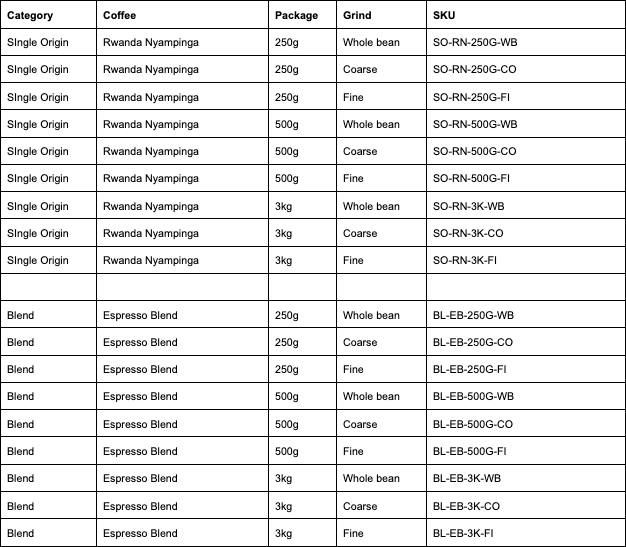Introduction to Stock Keeping Units (SKUs)

| Commerce
Tracking inventory across multiple sales channels and production processes is an essential part of any business. It’s important to track individual products, but also a variety of variations for any product. For example, you might track your coffees in each size package and each grind size. For merchandise, you need to track inventory and sales of a variety of sizes of Chemex, Hario, and Melitta filters. T-shirts come in a variety of colors, styles, and colors and you will want to know how each performs. This can be a cumbersome process, but by implementing a coded system of SKUs, it simplifies the entire process and gives you better visibility for your business.
What a SKU isn’t
A SKU is just one type of product code used for internal business purposes. There are several other product codes that a company might encounter or develop that have distinct purposes and objectives. These other codes might relate to SKUs, but they are not SKUs themselves. Some examples include Global Trade Item Number (GTINs) which helped identify products on the global trade market. Some examples which you might run into include UPCs (GTIN-12), EANs (GTIN-13).
Many roasters are familiar with another type of product code, the “ICO Mark”: A combination of figures which includes the country code (3 figures), the code for the exporter or grower (4 figures) and the parcel number (4 figures). The ICO mark must be unique to each parcel of coffee (ICO Glossary: https://www.ico.org/glossary.asp). The ICO Mark is specific to green coffee, and an important tool for a roaster to keep track of green coffee purchases and inventory, but it is not a Stock Keeping Unit which applies specifically to the products a roaster sells.
Universal Product Codes (UPCs) are a specific use case, and one that many roasters may need to apply to their products when selling in grocery markets or in larger retailers. A UPC is a globally unique12 digit numeric code. UPC follows rules from the Global Standards Organization, and must be purchased and licensed by the roaster. A UPC is a unique code that often ties to a barcode, enabling automatic scanning of products by a cashier and point of sale system, an Amazon warehouse, or a wholesaler, to name just a few. No matter where an item is sold, it will have this same unique number. Because they serve different purposes, and since a UPC isn’t a logical code that can be easily read by a human, UPCs and SKUs should each be unique. In Europe, there are EANs (European Article Numbers), a 13 digit number usually associated with barcodes, as well.
Why SKUs are important
It’s important to track as much information as necessary to satisfy inventory, accounting, and production requirements. SKUs enable you to do this.
Keeping track of daily, weekly, monthly, and annual stock levels is fundamental to inventory management. Using a system of SKUs simplifies this and improves accuracy. If you are selling certified coffees and undergo FairTrade and / or Organic audits, having SKUs that define FTO coffees can simplify the process and certification.
You also shouldn’t restrict yourself to assigning SKUs to coffee. Any product that you put in inventory and sell should be assigned a SKU – from allied products to merchandise to cleaning supplies. Using stock keeping units is one tool to ensure that you can reorder before anything goes out of stock.
Your sales and marketing teams can also rely on SKUs. They become part of an easy reporting method to provide metrics to track sales. When you track sales, you know which products you should invest in from a marketing, product development, and inventory strategy.
Of course, you could accomplish this with product names and variations alone, but then you end up with a long description in reporting, packing, and invoicing, often making it more difficult to manage. With a clearly defined SKU system, you simplify data filtering and have access to more robust reporting that provides visibility into which of your products and variants are most popular.
Ultimately, using SKUs with your accounting, Point of Sale, and website platforms ensures that every system integrates accurately and simplifies reporting about multiple products across a variety of platforms.
Examples
The best practice when developing your SKU scheme is to be sure that your stock keeping units include a coded description of the coffee (producer, country of origin, processing, etc.), bag size and weight, and any information about grind without developing a code that is so complex as to be unwieldy.
Here is an example of SKUs for two different coffees in a roastery. In this example, we have a single origin (coded SO) coffee from the Rwanda Nyampinga cooperative (coded RN) and a Blend for Espresso (coded BL-EB). The roastery sells coffee in 250g (250G), 500g (500G), and 3kg 3K) packages. They offer the coffee as whole bean (WB), ground coarse (CO), and ground fine (GF). This combination of product, package, and grind for only two coffees results in 18 distinct stock keeping units! Having a simple coding system simplifies managing this data, and simplifies using myriad tools to manage your business, including account systems, commerce shops, and production management tools like Cropster.
Cropster and SKUs
Cropster customers can find immediate benefit from adopting a system of SKUs. Our Order to roast and product features can use SKUs to simplify production planning and reporting, providing a grinding and packaging report that SKUs can organize for your production teams to accurately and efficiently organize the tasks of fulfilling orders.
Within our Commerce platform, SKUs can apply to products, which then carry into a linked accounting system and the aforementioned Order to roast features in Cropster. This reduces the steps required to build a production plan, increases the accuracy on your production floor, and provides improved reporting from your accounting platform and Cropster.
Cropster helps you make SKUs!
When creating your own SKUs, here are some best practices:
- Limit use of “0”, “O”, “I”, and “L” to minimize confusion
- Ensure that the SKU is unique for each product
- Use dashes to separate qualities (and avoid the use of other special characters)
- Develop a pattern and stick to it, and include variations if necessary:
- Category
- Name
- Variation 1 (e.g. Package Size for a bag of coffee, size for a t-shirt)
- Variation 2: (e.g. Grind for coffee, color for a t-shirt)
To make this even easier, we have a special gift for you to help you create your own SKUs. Fill out the form below to download an Excel application that auto-generates SKUs following many of the best practices we describe above – and it resolves any codes that may be duplicated in the instance of similar product names, categories, and variants.
If you’re interested in learning more, watch our SKU Webinar here!


